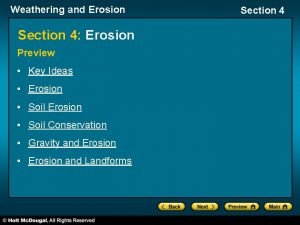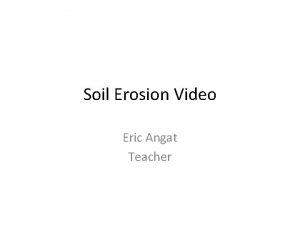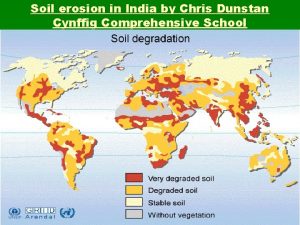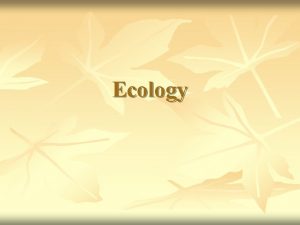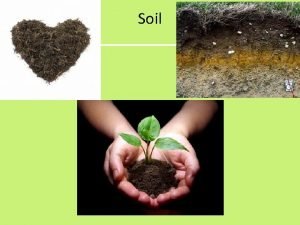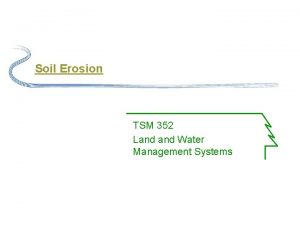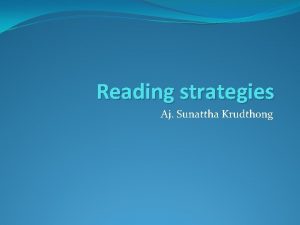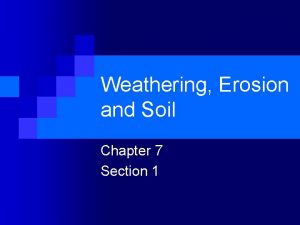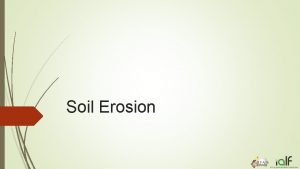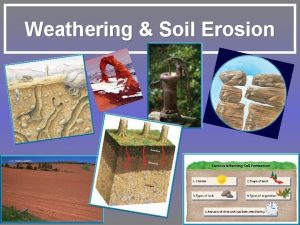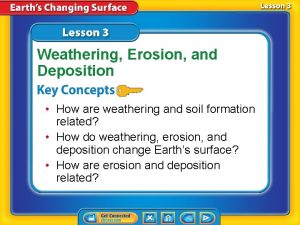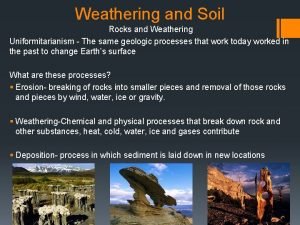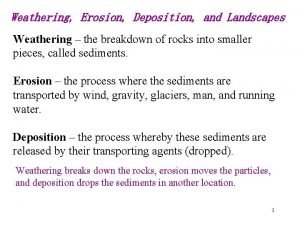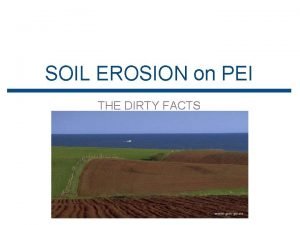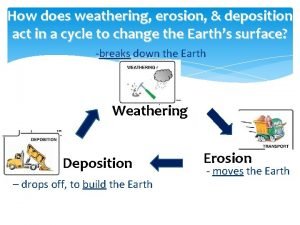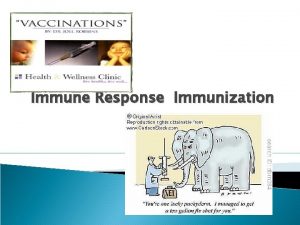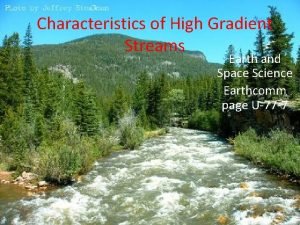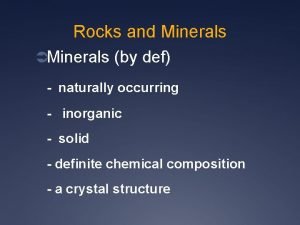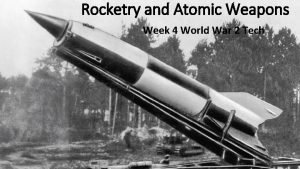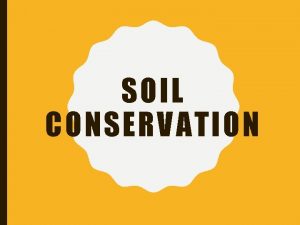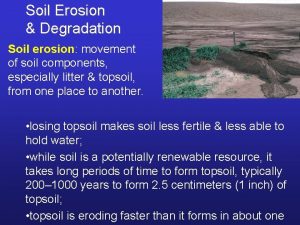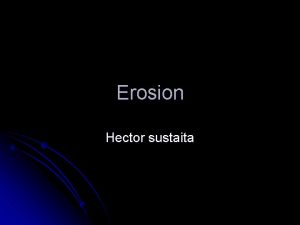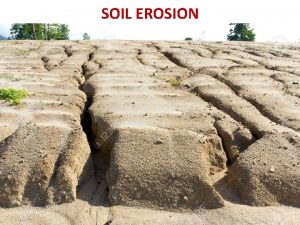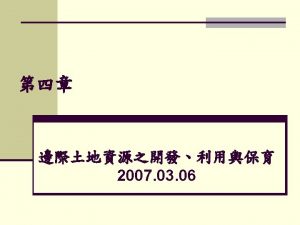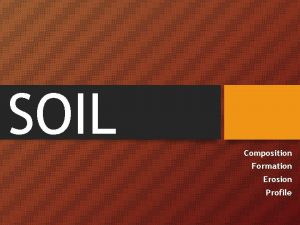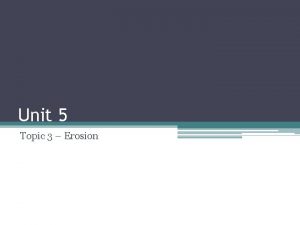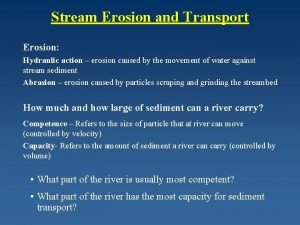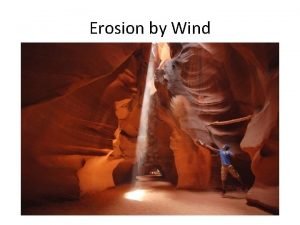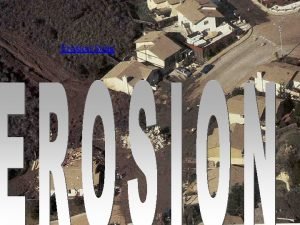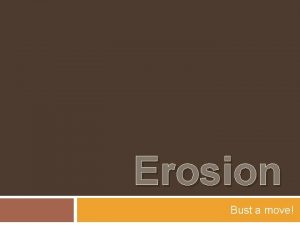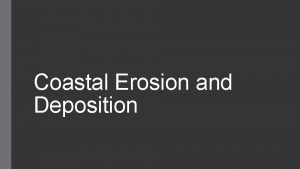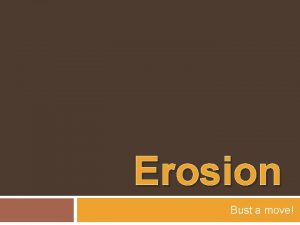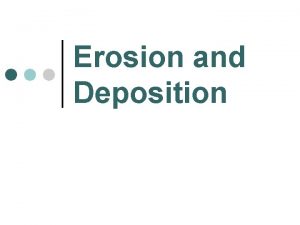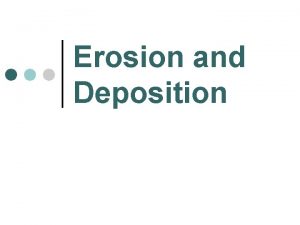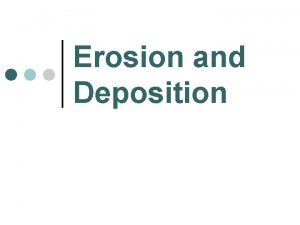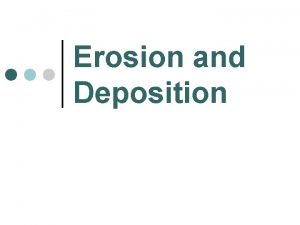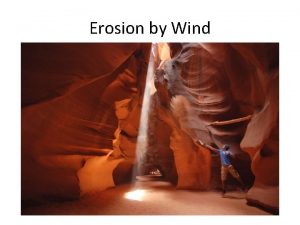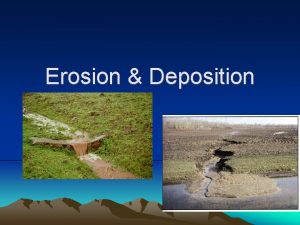Soil Erosion What is Soil Erosion Definition Naturally



























- Slides: 27

Soil Erosion

What is Soil Erosion? Definition: Naturally occurring process that affects all landforms Agriculture Definition: erosion refers to the wearing away of a field’s topsoil by the natural physical forces of water and wind and the forces associated the farming activities such as tillage.

Types of Erosion Water Erosion Wind Erosion Tillage Erosion Sheet Erosion Rill Erosion Ephemeral Erosion Gully Erosion

Water Erosion Soil loss resulting from the action of moving water Factors Influencing Water Erosion Excess rainfall Topography: how the land is arranged by natural and physical features of an area (rolling hills, flat prairie land, deep ravines) and how movement of water flows

Wind Erosion Soil loss resulting from the action of moving water Factors Influencing Wind Erosion Soil Cover: refers to vegetation, including crops, and crop residues on the surface of the soil. Land Management: process of managing the use and development (in both urban and rural settings) of land resources. Soil surface type (smooth, rough, covered, exposed)

Tillage Erosion The redistribution of soil through the action of tillage and gravity. Types of Tillage Primary tillage- tillage which inverts, cuts or shatters the soil to a depth of 15 -36 cm. Usually leaves the soil rough Moldboard plows, disk plows, chisel plows, sweep plows, powered rotary tillers, listers/bedders Secondary Tillage- tillage operations that follow primary tillage. The purpose is to prepare a final seedbed that is suitable for planting, seed germination, and weed control Disk harrows, field cultivators, powered rotary tillers, roller packers, bed shaping equipment and weed control equipment

Other Types of Erosion Types of erosion that are effects of water, wind, and tillage erosion Sheet Erosion—Gradual removal of soil in thin layers by raindrop impact and shallow surface flow. Results in loss of the finest soil particles. Rill Erosion—Loss of soil in small but visible tracks that are less than 20 cm deep that can be removed by normal cultivation. Develop when surface water concentrates in depressions or low points. Ephemeral Erosion—small channels eroded by concentrated flow that can be easily filled by normal tillage, only to re-form again in the same location by additional runoff events. Gully Erosion—Loss of soil in large, often impassible trenches or ditches resulting from runoff. Channels are deeper than 30 cm and cannot be removed by normal cultivation.

Check Point 1. What are three main forms of erosion? 2. What is the difference between rill and gully erosion? 3. Name two forms of primary and secondary tillage.

Impacts of Erosion on Soil Quality Wears away top soil which is composed of organic matter Top soil is the most fertile part of the land with the most nutrients for growing crops, and it takes up to a thousand years to develop one inch of new topsoil. Organic Matter: consisting of plant and animal residues at various stages of decomposition, cells and tissues of soil organisms, and substances synthesized by soil organisms. Organic matter is a small fraction (2% to 4%) of soil mainly present on the soil surface. Organic matter contributes to productivity through its effect on the physical, chemical, and biological properties of the soil. Erosion gradually depletes organic matter and decreases soil productivity

Soil Management Goals 1. ) To sustain and protect soil 2. ) Enhance its performance Working on these goals allow a way for farmers to farm profitably and preserve environmental quality for decades to come.

Ways to Reduce Soil Erosion Conservation Practices Contour buffer Strips Contour Farming Cover Crops Crop Rotation Nutrient Management Residue Management: No-Till Field Borders Grassed Waterways Terraces Windbreaks Bioreactors Link: https: //www. extension. iastate. edu/agdm/crops/html/a 1 -41. html

Contour Buffer Strips Definition: Narrow strips of perennial vegetation established across the slope and alternating down the slope with wider cropped strips Purpose: Reduce sheet and rill erosion Manage runoff water and trap sediment Provide food and nesting for wildlife (Duffy, n. d. )

Contour Farming Definition: Farming sloping land (preparing, planting, and cultivating) on the contour and not up and down the slope. Purpose: Reduce sheet and rill erosion Manage runoff water Reduce fuel consumption Used on sloping land (Duffy, n. d. )

Cover Crops Definition: A green crop including grasses, cereal grains, legumes or forbs seeded in the early fall to protect the soil surface from erosion and reduce sediment and nutrient loss during the winter months between growing seasons. Purpose: Holds soil in place over the winter Suppresses weeds Reduces soil erosion Provides cover to land topsoil Reduces nitrate leaching, improve soil health and productivity Increases soil organic matter content Controls insects (Duffy, n. d. )

Crop Rotation Definition: Growing different revenue-generating crops in a repeated sequence on the same field. Purpose: Reduce sheet, rill and wind erosion Maintain or improve soil organic matter content Manage the balance of plant nutrients Manage plant pests (weeds, insects and diseases) (Duffy, n. d. ) Ex: Year 1 - Corn, Year 2 - Soybeans, Year 3 - Corn, Year 4 - Alfalfa, Year 5 - Corn

Nutrient Management Definition: Careful management of the amount, source, placement, form and timing of the application of plant nutrients and soil amendments. Purpose: Reduce fertilizer cost (by not over applying) Protect water quality (by reducing amount of nutrients applied) Maintain of improve the physical, chemical and biological condition of the soil (Duffy, n. d. )

No-till Farming Definition: Soil and residue is left undisturbed from harvest to planting. Planting, drilling or nutrient application is done in a narrow seedbed or slot created by coulters, row cleaners, or disk openers. No full-width tillage operations are done. Purpose: Reduce sheet, rill, and wind erosion Improves soil organic matter content and soil structure Increase plant-available moisture Provide food and habitat cover for wildlife (Duffy, n. d. )

Field Borders Definition: Strip of perennial vegetation established at the edge or around the perimeter of a field. Used with contour or cross slope farming patterns. Purpose: Reduce erosion from wind and water Protect soil and water quality Manage pest populations Provide wildlife food and cover Improve air quality and increase carbon storage (Duffy, n. d. )

Grassed Waterways Definition: Areas planted to grass or other permanent vegetative cover where water usually concentrates as it runs off a field. Purpose: Slows water and helps guide it off the field Prevents gully erosion to form (Duffy, n. d. )

Terraces Definition: Manmade structures that follow the contour of a hillside, breaking a long slope into smaller segments. Purpose: Reduce rate of runoff and allows the soil particles to settle. Reduces erosion by holding back the water on a field and slowing it down as it moves down the hill. Used on hillsides and in steep areas of a field Gives a stair stepped appearance (Duffy, n. d. )

Windbreaks Definition: Rows of trees and shrubs planted around a farmstead, field or feedlot. Purpose: Protects from wind erosion Acts as a snow fence Provides wildlife food and cover Acts as a sound barrier (Duffy, n. d. )

Bioreactors Definition: An underground trench of woodchips at the end of a tile line. Water from the tile flows through the woodchips before entering a stream or river. Microorganisms live in the woodchips. These microorganisms “breath” the nitratenitrogen from the water. Then they release the nitrogen into the air, making it harmless. Purpose: Reduces nitrogen runoff (Duffy, n. d. )

Check Point 1. What conservation practice farms/plants on the contour and not up and down the slope? 2. Explain what no-till farming is and its purpose. 3. What are the soil management goals?

Questions? ?

Soil Erosion Activity We will now put your knowledge to the test! In this activity we will be observing the effects of water erosion on various soil types. The objective is to identify types of erosion taking place by the force of water and then use the information of different soil conservation practices to create a solution to controlling water-induced topsoil erosion with different soil types. Your plan needs to be well thought out and then constructed using various materials. You must put an estimation on the cost of the plan and identify where this solution can be used in a practice.

Soil Erosion Activity 1. Observe the different types of erosion taking place on the stream table. 2. Identify one or multiple types of erosion taking place and begin to develop a solution for it. 3. Map out your plan on a piece of paper (include drawing, machinery needed, costs of plan, and where the plan can be most beneficial in a practice. (Please use 2 outside resources for your plan and cite accordingly) 4. Construct your plan with the provided materials and then test it out on the stream table.

Sources/Resources Duffy, M. (n. d. ). “Conservation practices for landlords. ” Iowa State University Extension and Outreach. Retrieved from https: //www. extension. iastate. edu/agdm/crops/html/a 1 -41. html
 Erosion types
Erosion types Weathering and soil erosion
Weathering and soil erosion Soil
Soil Soil erosion in india
Soil erosion in india Soil erosion caused by human activities
Soil erosion caused by human activities Type of erosion
Type of erosion Four components of soil
Four components of soil Soil erosion
Soil erosion Passage 1 opera
Passage 1 opera Chapter 7 weathering erosion and soil
Chapter 7 weathering erosion and soil Soil erosion def
Soil erosion def The rate of weathering depends upon the area's ____
The rate of weathering depends upon the area's ____ Weathering and soil erosion
Weathering and soil erosion How does temperature break down rocks
How does temperature break down rocks Rolling plains weathering erosion and deposition
Rolling plains weathering erosion and deposition Agent of erosion
Agent of erosion Factors affecting soil erosion
Factors affecting soil erosion Detachment transportation and deposition
Detachment transportation and deposition Types of weathering
Types of weathering Living soil vs dead soil
Living soil vs dead soil Four major spheres of the earth
Four major spheres of the earth Naturally acquired passive immunity definition
Naturally acquired passive immunity definition Erosion definition
Erosion definition Minerals def
Minerals def Heaviest naturally occurring element
Heaviest naturally occurring element Advantages of geothermal energy
Advantages of geothermal energy What problem
What problem Signing naturally 8:7 minidialogues
Signing naturally 8:7 minidialogues

